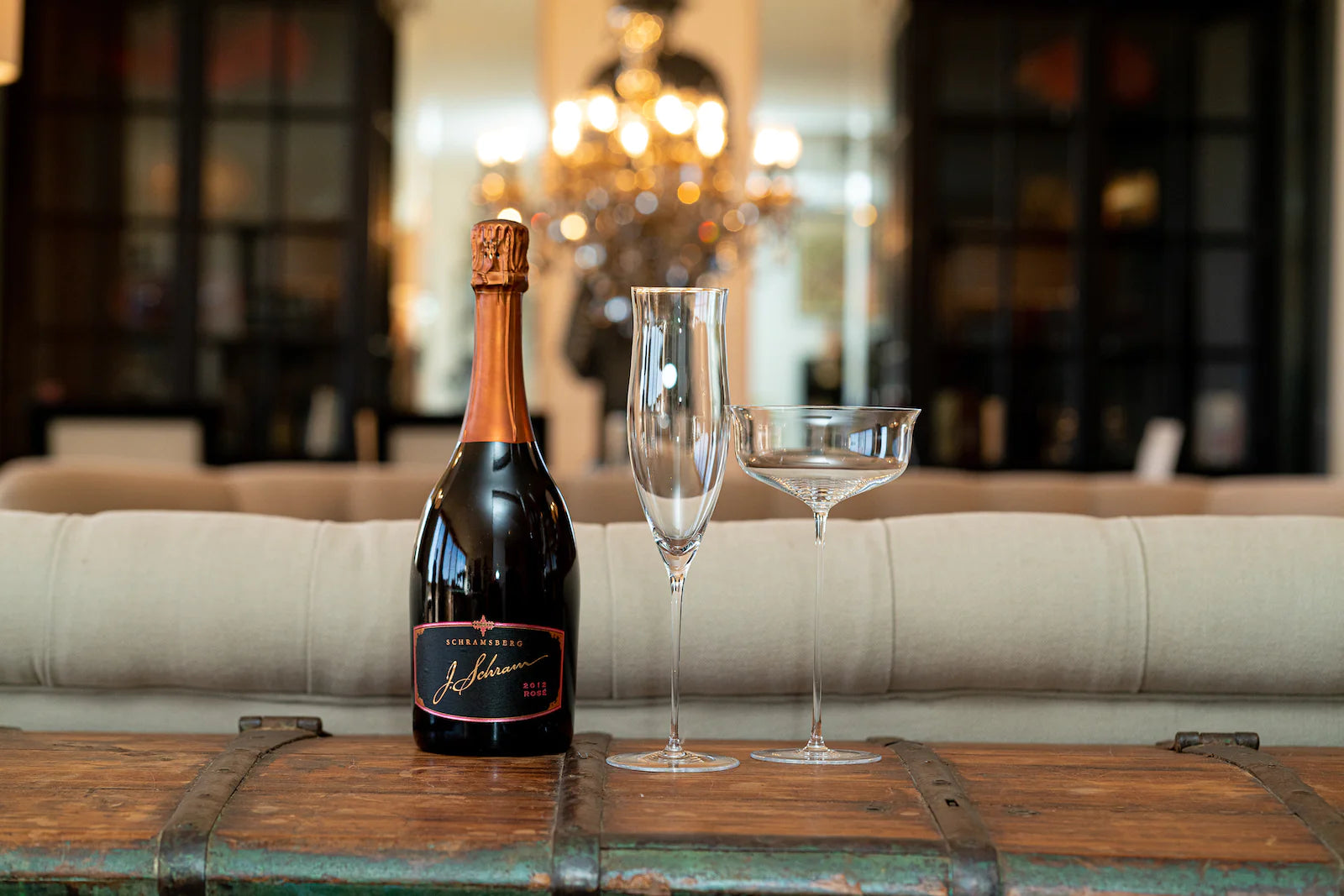
Champagne, the name derived from its breathtaking site of origin, is an elegant, sparkling wine made primarily from the grapes of Pinot Noir, Chardonnay, and Pinot Meunier. There are 15 different types of Champagne, ranging from the driest Brut Nature to the sweetest Doux, each with its own distinct flavors and effervescence to give your tastebuds a delectable treat.
Having the right glass for your bottle of bubbly accentuates the tasting experience tenfold. Every bubble on the palette and every whiff of the aromas is elevated by having the appropriate glass for your Champagne of choice. Knowing the different types of glasses will help you determine the perfect set to pair with your Champagne.
Fran Berger is a refined home entertaining and sophisticated living expert with over 25 years of experience. Through her unique combination of elegance and edge, Fran helps to create a lifestyle that elevates the everyday for her prestigious clients - including curating her very own signature collection of luxury Champagne glasses.
Now, let’s review the different types of Champagne glasses to choose from so that you can inspire unforgettable moments within your home for you and your guests.
Types Of Champagne Glasses
1. Champagne Flute
Flutes are a classic glass of choice for tasting Champagne and my favorite shape of glass! Champagne flutes are designed specifically for Champagne and sparkling wine, exhibiting a lengthy stem and an elongated, slender bowl. This style of Champagne glass is most desirable because it helps to preserve the bubbles, while the longer stem prevents hands from warming the liquid too quickly.
Flutes are good for elevating any occasion, especially when you use my signature collection Champagne flutes. These oversized, 100% lead-free crystal glasses are hand-blown by artisans in the Czech Republic and possess a graceful and elegant design, with a slight flare at the top of each glass, finishing with a paper-thin rim. The way they sit so lightly in your hand and on the lip truly elevates the whole drinking experience.
These glasses are sophisticated enough for those monumental celebrations as well as toasting to the smaller, more intimate moments. They are sold in pairs (2 flutes) at $260 each.
Shop The Fran Berger Signature Champagne Flute.
2. Stemless Champagne Glasses
Stemless Champagne glasses duplicate the slim body and narrow rim of a flute but have a flat base rather than a long stem. This style is simple and modern, yet still classy and graceful for any occasion. Stemless glasses optimize the bouquet, taste, effervescence, and balance of all kinds of Champagne and sparkling wines so that you can still have the same tasting experience with an effortless look.
3. Champagne Coupe
Coupe glasses were more popular in the 1950s, with their design displaying a very wide, saucer-like shape and a shorter stem. The wideness and shallowness of the bowl expose the liquid to air, which quickly depletes the bubbles and softens the taste of your Champagne.
If you don’t like too many bubbles in your sparkling wine then this is a good type of glass to use. It is also an iconic and timeless style to use at themed occasions and holidays. It is best enjoyed with a much sweeter wine, such as a Brut or Doux.
Shop The Fran Berger Signature Coupe.
4. Champagne Tulip
The Champagne tulip is a recognizable and the more commonly used style of glass, with its wider-flared body and tapered mouth. It is ideal for Champagne tasting because of how its shape gradually widens in the center of the glass. This allows the aromas to fully develop, as well as gives space for the bubbles to accumulate and pop. Tulips also maintain a longer stem, so that you can avoid warming your wine or leaving finger smudges along your glass.
The Champagne tulip glass is ideal for any tasting experience, whether it’s hosting an elegant dinner party or just simply enjoying it with a book and cozy blanket on a cool, autumn night.
5. Wide Tulip Champagne Glass
Much like the tulip, the wide Champagne tulip glass offers the same graceful shape, but the wideness of the bowl is lower and located more towards the stem. This is practical for collecting aged flavors found in vintage Champagnes, or Champagnes made from grapes from a single year. High-quality Champagnes, such as Dom Perignon, should be enjoyed in a wide tulip glass. The wide tulip will transform all of your dining and tasting experiences.
6. Trumpet Champagne Glass
The biggest difference between a flute and trumpet glass is the mouth - the Trumpet glass has a narrow body that opens up at that rim (like the instrument, hence the name). The concept of the trumpet glass is designed to concentrate on the champagne bubbles and maximize flavors on the tongue. This is best for those who enjoy lots of bubbles, especially right before that first sip!
Trumpet Champagne glasses come in all different shapes and sizes, from longer to shorter stems. Depending on the style of your home and your preference in length, this type of glass can truly make any basic dinner into one of class and significance.
How to Select a Type Of Champagne Glass
Choosing the right type of Champagne glass for your collection will require expertise and an eye for detail. Through her collection of home entertaining and design consulting services, Fran Berger will curate these bespoke experiences, helping you to celebrate the moments that matter in your life. Her passion for unrivaled elegance comes through in her signature collection of Champagne flutes, perfect for toasting to every moment, big or small.
Having worked with an extensive list of elite clients, Fran can assist you with all aspects of your home design, curating and collaborating closely with industry-leading lifestyle brands and interior designers selected specifically for you and your needs.
Can You Drink Champagne in a Regular Wine Glass?
Of course, champagne can be consumed in an ordinary wine glass and it will only make it even better in every way. The British flute is thin in order to maintain the formation of the bubbles and to let them rise and be displayed but a standard stem—especially one with a larger bowl—actually enhances the scent and the taste of the Champagne even more. The same goes for the bouquet in vintages or in the more quality category Champagnes. This wider form enables a better aeration, which seems useful to particularly enjoy these subtleties, maybe slightly masked within a narrower flue. So, if you really want to get into the subtleties of your Champagne, do not hesitate to use a regular wine glass.
Does the Type of Champagne Glass Matter?
Champagne glasses, though they represent a variety of unique, eye-catching styles, are carefully crafted to provide you with the best Champagne tasting experience possible. From the way the tight bubbles reach your lips at the opening of the rim to the way an elongated stem sits light and airy in your hands, having the right glass for your favorite bottle of Champagne works to heighten all of your senses.
An open-topped shape, like the coupe and trumpet glasses, allows the bubbles to escape quickly into the air. This smoothes the feel of the Champagne on your palette and gives you more flavor than bubbles. In contrast, glasses with a wider bowl and narrower rim, such as a tulip, restrict the bubbles from quickly dispersing, giving the aromas and flavors time to expand and funneling them towards the nose.
When choosing the right type of Champagne glass to add to your home’s collection, consider both the design, as well as the feel of the glass in your hand. The right glass should complement your own unique style, as well as create an incomparable Champagne tasting experience, every time. For more inspiration, visit Fran Berger’s website to browse her recommended products, along with an array of services offered.

























